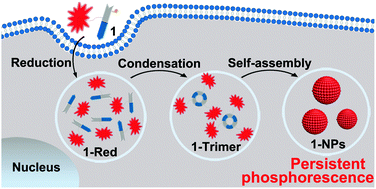当前位置:
X-MOL 学术
›
Chem. Commun.
›
论文详情
Our official English website, www.x-mol.net, welcomes your feedback! (Note: you will need to create a separate account there.)
Intracellular self-assembly of Ru(bpy)32+ nanoparticles enables persistent phosphorescence imaging of tumors†
Chemical Communications ( IF 4.9 ) Pub Date : 2018-03-12 00:00:00 , DOI: 10.1039/c8cc01759j Jindan Li 1, 2, 3, 4, 5 , Zijuan Hai 1, 2, 3, 4, 5 , Huiqiong Xiao 5, 6, 7, 8 , Xiaoyi Yi 5, 6, 7, 8 , Gaolin Liang 1, 2, 3, 4, 5
Chemical Communications ( IF 4.9 ) Pub Date : 2018-03-12 00:00:00 , DOI: 10.1039/c8cc01759j Jindan Li 1, 2, 3, 4, 5 , Zijuan Hai 1, 2, 3, 4, 5 , Huiqiong Xiao 5, 6, 7, 8 , Xiaoyi Yi 5, 6, 7, 8 , Gaolin Liang 1, 2, 3, 4, 5
Affiliation

|
Nanoprobes are advantageous over small molecular probes in sensitivity but most luminescence molecules used to construct nanoprobes often suffer from an aggregation-caused quenching effect. Herein, we rationally designed a small molecular probe Cys(StBu)-Lys(Ru(bpy)32+)-CBT (1) which “smartly” self-assembled into nanoparticles 1-NPs inside cells with non-quenched, persistent phosphorescence. Employing this property, we successfully applied 1 for long-term sensing of biothiol activity in living HepG2 cells and tumors. We envision that, by modifying the amino group with an enzyme substrate, our probe 1 could be further developed for sensing intracellular enzyme activity with non-quenched, persistent phosphorescence.
中文翻译:

Ru(bpy)3 2+纳米粒子的细胞内自组装可实现肿瘤的持久磷光成像†
纳米探针在灵敏度上优于小分子探针,但是大多数用于构建纳米探针的发光分子通常遭受聚集引起的猝灭作用。在此,我们合理设计了一种小分子探针Cys(S t Bu)-Lys(Ru(bpy)3 2 +)-CBT(1),该探针“智能地”自组装为具有非猝灭作用的细胞内部的纳米颗粒1-NP,持续的磷光。利用这种特性,我们成功地将1用于长期检测活HepG2细胞和肿瘤中的生物硫醇活性。我们设想,通过用酶底物修饰氨基,我们的探针1 可以进一步开发用于感测具有非猝灭性持续磷光的细胞内酶活性。
更新日期:2018-03-12
中文翻译:

Ru(bpy)3 2+纳米粒子的细胞内自组装可实现肿瘤的持久磷光成像†
纳米探针在灵敏度上优于小分子探针,但是大多数用于构建纳米探针的发光分子通常遭受聚集引起的猝灭作用。在此,我们合理设计了一种小分子探针Cys(S t Bu)-Lys(Ru(bpy)3 2 +)-CBT(1),该探针“智能地”自组装为具有非猝灭作用的细胞内部的纳米颗粒1-NP,持续的磷光。利用这种特性,我们成功地将1用于长期检测活HepG2细胞和肿瘤中的生物硫醇活性。我们设想,通过用酶底物修饰氨基,我们的探针1 可以进一步开发用于感测具有非猝灭性持续磷光的细胞内酶活性。


























 京公网安备 11010802027423号
京公网安备 11010802027423号